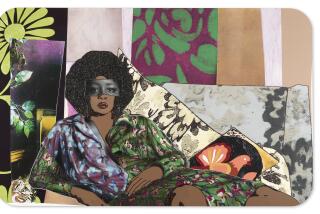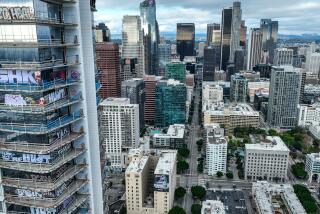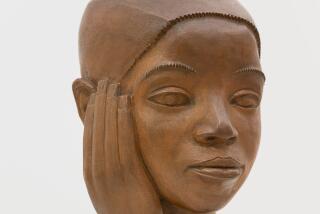Review: Searing moments of American truths in ‘Soul of a Nation: Art in the Age of Black Power’
On Sept. 13, 1971, the deadliest prison upheaval in American history came to a blood-spattered end just east of Buffalo, N.Y., with more than 40 prisoners and employees dead at the notorious Attica Correctional Facility. Prisoner demands for humane treatment were met with an institutional show of force.
In response, artist Faith Ringgold drew a devastating map.
A copy hangs in the second room of “Soul of a Nation: Art in the Age of Black Power, 1963-1983,” a large and ambitious traveling exhibition downtown at the Broad. Nearly half a century on, Ringgold’s image still shocks. Partly that’s because it resonates against mass incarceration as a defining civil rights issue today.
The prison rebellion embodied elements of a national history that remained very much repressed. Attica held nearly twice as many inmates as the penitentiary had been designed for, more than half of them black Americans; the correctional staff was largely white. Ringgold titled her map, which she mass-produced as a lithographic poster, “United States of Attica.” As the civil rights movement slowly advanced, pushback was being felt.
The map shows the country divided into quadrants, a crisscross that recalls the view through the scope of a rifle. Red, green and black — the colors representing blood, fertility and the African diaspora in the now hundred-year-old Pan-African flag — make the target explicit.
SPRING ARTS PREVIEW: Critics’ recommendations and emerging artists to know »
Annotations written across almost every state, as well as in areas beyond the country’s borders, chronicle brutal episodes of lynching, rape, war, indigenous genocides and other violence. A caption invites adding whatever incidents of mayhem might be missing.
This is not a Jasper Johns-style map, on which a beautifully chaotic array of brushy color and stenciled, misdirected place-names brilliantly re-imagines what a work of art is or might be. Ringgold’s chaos is instead declarative and relentless. The carnage piles up.
Her shrewd map also subtly encodes Johns as a major American artist consecrated by New York’s Museum of Modern Art, which famously acquired three paintings in 1958 from the then-unknown artist’s first gallery show. The Attica debacle was managed by Gov. Nelson Rockefeller, whose family founded MoMA.
“Soul of a Nation” is filled with many such searing moments. Organized by London’s Tate Modern, it features about 145 paintings, sculptures, drawings, photographs and prints, plus ephemera (letters, magazines, notebooks, documentation, etc.) by more than 60 artists. That a British modern art museum is telling a distinctly American story is not only unexpected, it also might harbor an unforeseen advantage.
The story of African American art is more underknown than unknown. In the United States, individual figures such as painter and collagist Romare Bearden, photographer Roy DeCarava, assemblage artists David Hammons, Noah Purifoy and Betye Saar, sculptor Martin Puryear and several others are well established.
As a larger contemporary movement, however, black art has languished in an institutional blind spot, with sporadic attention such as the UCLA Hammer Museum’s impressive “Now Dig This! Art and Black Los Angeles,1960-1980” in 2011. Given a sprawling history seen from far afield, Tate curators Mark Godfrey and Zoe Whitley found a useful contextual framework that illuminates a subject both broad and complex.
They chose a related pair of emphases.
One is on artists as individual creators working within a heightened sense of community, essential to the social stresses of the black power era. The other is a city focus — convergences in the major artistic centers of Los Angeles, Chicago and New York. Groups like Harlem’s Kamoinge Workshop and Chicago’s AfriCobra gain clarity.
At the Broad, the story unfolds in 11 chapters. It begins with the Spiral, an eclectic affiliation of 15 New York artists who came together to ponder what black artists could do to advance civil rights. They produced a single 1965 exhibition in which diverse works were all in black and white, such as Norman Lewis’ jagged vision of the Ku Klux Klan as white lacerations across the painting’s black surface-skin.
Other sections examine difficult questions. Who should the audience be for artists largely estranged from establishment art venues? What about abstraction for a movement aimed at social consciousness?
That question was often answered with analogies to music or textiles, as in the staccato luminescence of Alma Thomas’ abstract paintings. Jack Whitten gives a deft reply in his “Homage to Malcolm X,” exposing pools of red and green underpainting in a pyramid-shaped canvas by dragging an Afro-pick comb through a black surface layer.
REVIEW: Charles White show at LACMA pinpoints the power of an underappreciated black artist »
One room considers photography as both journalism and art, mechanisms for maneuvering within and around media representation. Another takes the next step — painted portraiture, highlighted by Barkley L. Hendricks’ 1969 self-portrait wearing nothing but a Superman T-shirt. With determined wit, his superhero pose elevated to the next level the iconic “I Am a Man” protest made the year before by striking sanitation workers in Memphis, Tenn.
The show takes off in the fifth gallery, which looks at L.A. assemblage artists.
At one end is Saar’s 1972 “I’ve Got Rhythm,” a tabletop sculpture that transforms Man Ray’s “Indestructible Object,” a Surrealist metronome sporting an all-seeing eye on its pendulum, into a blistering, ticking time bomb on the subject of lynching. At the other is Purifoy’s astounding painting “Watts Riot,” made from salvage gathered in the wake of the disastrous 1965 event and arguably the most sensuously beautiful work of art ever wrenched from conflagration.
Assemblage pulls together and repurposes discarded objects — an art of the superfluous and the overlooked yielding new and essential life. Prominent in L.A. since the 1950s, by the next decade it offered an open-ended sense of possibility for artists within a burgeoning art scene in a city without a strong institutional fabric.
Saar, Purifoy, Hammons, John Outterbridge, Melvin Edwards — black artists ran with it. As a loose community of talented individuals, they had nothing to lose and everything to gain.
LACMA: Troublesome signs in a risky reorganization plan »
The show does have small stumbles. A few works on black subjects by accomplished artists who are white (painter Alice Neel) and Japanese (photographer Ruiko Yoshida and poet Hajime Kijima) mean to acknowledge staunch black power allies, but they come across as distractions. Daniel LaRue Johnson’s painted totem-sculpture is installed next to a wall, obscuring the spiritually minded, Barnett Newman-like stripe on the back.
The primary oddity, however, is the bigger frame provided by the entry and exit rooms.
The show closes with a selection of work shown at Just Above Midtown, an influential New York gallery that sought to cultivate a black collector base by operating at the epicenter of the 57th Street art market between 1974 and 1977. (Several L.A.-based African American artists showed there.) Recall that “Soul of a Nation” opens with the Spiral group, formed a decade earlier by a wide range of artists mulling what one writer described as “their attitudes and commitments as Negro artists in the present struggle for Civil Rights.”
Perhaps inadvertently, the nation’s cultural soul is framed as a fight to move from social marginalization to a secure place within the art market. That narrative might be one opportune consequence of black power, but it’s unlikely to rank as the highest aspiration for a historic project with imperative political and philosophical dimensions. Happily, the art’s strength and the exhibition’s otherwise savvy organization overcomes it.
♦ ♦ ♦ ♦ ♦ ♦ ♦ ♦ ♦ ♦
‘Soul of a Nation: Art in the Age of Black Power 1963-1983’
Where: The Broad, 221 S. Grand Ave., L.A.
When: Tuesdays-Sundays, ends Sept. 1
Admission: $12-$18; advance timed entry tickets recommended, free entry 5-8 p.m. Thursdays with last entry at 7 p.m. (General admission to the rest of the museum is always free.)
Info: (213) 232-6200, thebroad.org
More to Read
The biggest entertainment stories
Get our big stories about Hollywood, film, television, music, arts, culture and more right in your inbox as soon as they publish.
You may occasionally receive promotional content from the Los Angeles Times.











